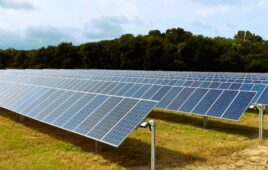By Dan Glaser, Sales Engineer, Panasonic Life Solutions of North America
For anyone who has been paying attention to energy trends over the last year, it’s clear that energy storage is huge in the residential solar market. In fact, according to a recent Wood Mackenzie U.S. Energy Storage Monitor report, Q2 of 2020 saw residential battery installations grow 38% compared to Q1, indicating that installations have remained resilient in spite of the pandemic. Though, even as some homeowners put solar installation plans on hold during the COVID-19 crisis, the urgency of tax credits — which end next year — can’t be ignored.
But after energy storage becomes a mainstay of the solar industry, what’s next? While solar + storage is expected to continue to grow in popularity, the overall energy storage market is projected to reach $6.9 billion annually by 2025. The future is bright as we look to more opportunities to advance solar energy and increase homeowners’ control over their home energy systems.
Personalization
 Residential energy storage is customizable to fit every home’s individual needs. But manufacturers differ in their approach to product solutions. Some manufacturers provide customers with a choice between AC- and DC-coupled batteries with a wide range of kilowatt-hour scaling options, whereas others provide a one-size-fits-all approach. After installation, most energy storage systems allow the homeowner to change basic system operation via a smartphone app. These settings typically include operating modes and percent dependence on battery reserve, which may be set to specific times to use the battery during the day, or setting the battery charge level to 100% in anticipation of a grid outage.
Residential energy storage is customizable to fit every home’s individual needs. But manufacturers differ in their approach to product solutions. Some manufacturers provide customers with a choice between AC- and DC-coupled batteries with a wide range of kilowatt-hour scaling options, whereas others provide a one-size-fits-all approach. After installation, most energy storage systems allow the homeowner to change basic system operation via a smartphone app. These settings typically include operating modes and percent dependence on battery reserve, which may be set to specific times to use the battery during the day, or setting the battery charge level to 100% in anticipation of a grid outage.
As batteries continue to gain popularity among homeowners, the next evolution in energy storage will be wider adoption of solutions that provide more insight into energy consumed by different devices throughout the home, and enable the homeowner to make better decisions in how and when they use energy. Leaders in the industry have the opportunity to bring homeowners “smart” solutions that learn their individual preferences for energy expenditures and automatically optimize the home’s usage via advanced algorithms.
One way this may come to life is through smart load centers, which capture and analyze a home’s energy usage, even when no one is home. By monitoring which loads are in use during peak hours, these centers can adjust accordingly to conserve energy for when it’s needed most. Battery providers may also begin to partner and integrate with developers of smart electrical panels, which would give homeowners greater visibility into their energy storage systems and better control how it they’re used. Advanced custom solutions like this will allow homeowners to tailor their batteries to fit their lifestyle, give them insights into how minor behavior shifts and product settings can lower their energy consumption and provide the highest value — and are the next steps in residential storage innovation.
Integration
Today, leading storage systems come equipped with advanced software and user-friendly apps for homeowners that allow customization between multiple operating modes and visibility into system status. Existing PV and energy storage systems operate in silos; the biggest challenge then, and one of the next major innovations in storage, will be connecting home automation, EV charging and other services into one, easy-to-control interface. Consumers already have this expectation of home conveniences for everything from HVAC systems to doorbells and security systems — energy storage and the applications that rely on it will soon be no different.
Integrated total home energy and automation solutions will allow homeowners to have greater control of their entire suite of devices. In the future, homeowners will conveniently access their energy stores and choices on a single app, managing their whole home’s energy usage from anywhere, at any time.
Business Optimization
 While residential storage will continue to become more integrated, convenient and widespread, installers can’t rely on these perks alone to make the sale. In 2021, homeowners who invest in solar and energy storage are eligible a tax credit of credit 22% (down from 26% in 2020) and eventually will reach 0% in 2022. The federal investment tax credit has stimulated much of the growth in the solar industry, so the credit reduction poses major risks for installers. The countdown will create increased pressure on installers, who are already challenged with proving the ROI of solar and residential storage to prospective buyers — especially in light of the many challenges brought by COVID-19 and a recession.
While residential storage will continue to become more integrated, convenient and widespread, installers can’t rely on these perks alone to make the sale. In 2021, homeowners who invest in solar and energy storage are eligible a tax credit of credit 22% (down from 26% in 2020) and eventually will reach 0% in 2022. The federal investment tax credit has stimulated much of the growth in the solar industry, so the credit reduction poses major risks for installers. The countdown will create increased pressure on installers, who are already challenged with proving the ROI of solar and residential storage to prospective buyers — especially in light of the many challenges brought by COVID-19 and a recession.
The reduction in the federal tax credit presents two specific opportunities for installers. First, by shifting their sales strategy to focus on total home energy solutions delivered by panels plus batteries — instead of just solar — they can bring customers one step closer to grid independence. Some will also experience a quicker return on their solar investment by using their stored energy from a battery during peak utility rate hours.
Second, while the phase out of the tax credit places even more pressure on installers to effectively communicate the value proposition of considering solar, it’s also a window of opportunity to look at their business models and get creative about mitigating cashflow risk for their own operations. Installers should look to work with strong partners and manufacturers who have the resources and experience to help them succeed as they navigate this challenging new landscape.
Smart home technology and its acceptance are changing the solar industry, and there are no signs of a slowdown. Within the next few years, increased personalization, integration and solar business optimization will transform how consumers buy energy storage and the level of control they expect from their solutions and providers. The coming changes make it all the more important to partner with firms that have proven staying power and the R&D chops to navigate change in the market.




Solar Technology is a major disruptor to reduce greenhouse gases and it will facilitate the change of status of consumer to prosumer in case of roof solar owner with suitable size of storage battery and afford him to exchange energy to grid or his neighbor during peak hours. This can be source of earning and become ‘Boss your own Business’. Early investment in Solar is attractive making use of Govt tax relief and be a boss of your own business.